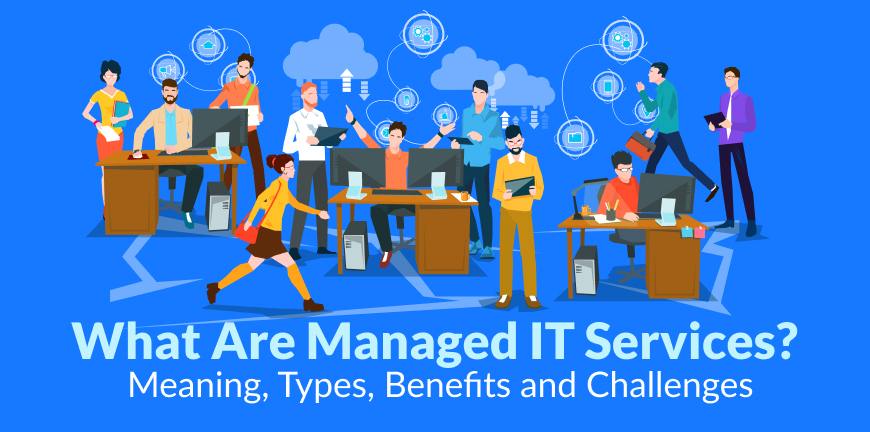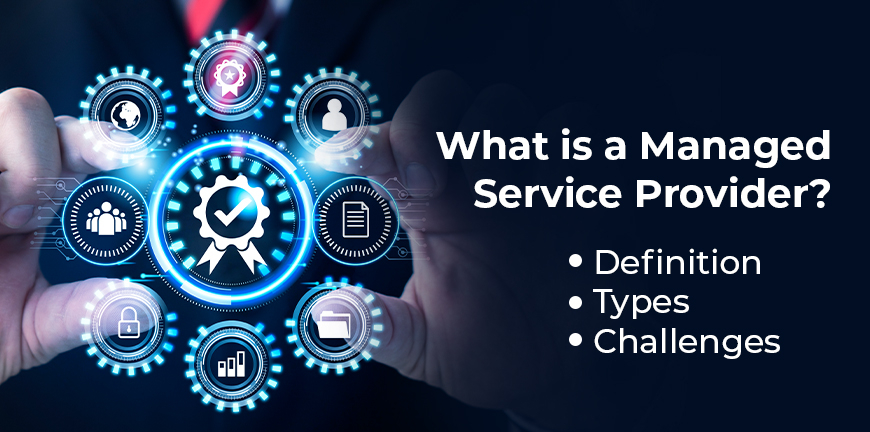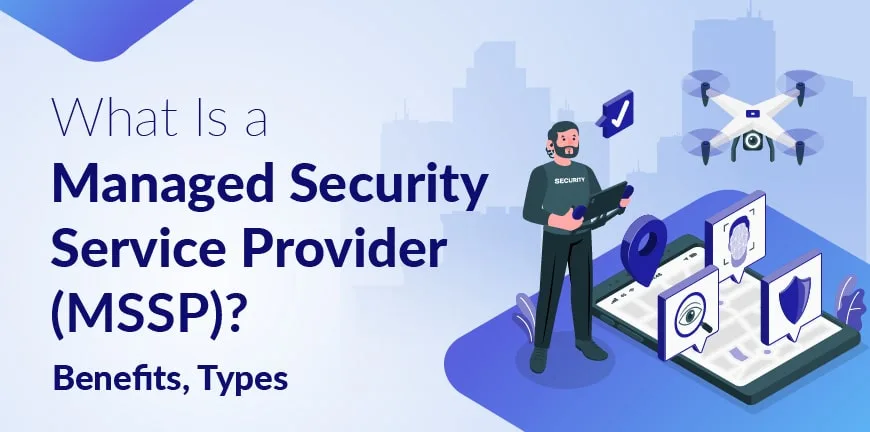
What Is Site Reliability Engineering (SRE)? Benefits, Practices & Implementation
08/07/2025
Top 5 Compliance Challenges Enterprises Face in 2025
08/07/2025- What are Managed IT Services?
- How do Managed IT Services Work?
- Why do businesses use managed IT services?
- What Types of Managed IT Services are Available?
- What Are the Benefits of Managed IT Services?
- What Challenges Are Associated with Managed IT Services?
- How to Choose the Right Managed IT Service Provider?
- Conclusion
- FAQs- Frequently Asked Questions
As a business grows so does its IT needs. Talking specifically about large enterprises that juggle thousands of user accounts, manage remote workers, maintain hundreds of servers, perform data backup for all, are usually pressed for time and resources. And all this while being worried about keeping up the operational continuity. Such organizations must consider managed IT services, meaning a third-party provider manages and maintains the company’s IT infrastructure and tasks, and helps streamline the operations.
What are Managed IT Services?
Managed IT Services allow organizations to outsource their IT tasks to an expert third party service provider. These services can help relieve workload of in-house teams, be an addition to the current team to help meet the IT demand. Managed service providers can ensure the IT activities are up and running around the clock, resulting in maximum productivity.
Under IT service management model, some of the services provided are-
- Remote monitoring and management of IT infrastructure
- Security services include incident response, monitoring, and testing.
- Configuration, monitoring, and management of cloud services
- Communications support.
How do Managed IT Services Work?
Managed IT Services are IT support services provided on a subscription basis to keep a company’s systems running smoothly. Remote monitoring and management of IT infrastructure is the primary goal of these services. With specialized tools, MSPs can easily oversee networks and detect issues before it harms and disrupts operations. Z
Service Level Agreements (SLAs) are established before MSPs provide their services. The SLA clearly states the response times, IT support, backup, and cybersecurity.
Various tech loke EDR software, RMM platform, professional services automation tools, antivirus, cloud management are made use of to enhance and maintain the system performance.
MSPs are an extension of your in-house team. They perform tasks like-
- Handle routine maintenance.
- Resolve user issues.
- Manage infrastructure.
- Align tech operations and business goals.
Why do businesses use managed IT services?
Bringing in help of managed IT services can help companies streamline their IT operations. Some of the key reasons for the need of managed IT services-
- Utilization of current technological trends
- Supplement in-house team to address lack of technical skills.
- Helps avoid cybersecurity threats through robust security measures
- Ensures compliance with systems and operations
- Helps save costs as critical tasks are outsourced avoiding training and hiring in-house employees.
What Types of Managed IT Services are Available?
1. Remote IT infrastructure monitoring
This involves supervising an organization’s IT activities to ensure high performance and detect issues before they become problems. Some of the services included are- monitoring servers, networks and applications for performance metrics, security breaches. MSPs provide real-time alerts and regular reporting to maintain system reliability, reduce downtime, and address issues proactively.
2. On-site managed IT support
While some IT issues can be solved remotely, issues related to hardware or systems installations need to be solve physically. Managed IT service providers deploy technicians to your office to manage all physical IT issues.
3. Project based managed services
When companies have big IT projects at hand, managed IT service providers deliver specialized support. This could include project management and technical expertise, especially if the project is time sensitive like cloud migrations, infrastructure upgrade or software rollouts.
4. Managed cybersecurity services
As a reliable managed IT services provider, we help safeguard an organization’s digital assets like firewall management, intrusion detection prevention systems, anti-virus and anti-malware solutions, threat hunting, incident response and more. All of this helps reduce cybersecurity attacks ensuring compliance with industry regulations.
5. Managed Cloud infrastructure
As part of managed IT services, MSPs provide administration and optimization of cloud environments, whether public, private, or hybrid is provided. MSPs also help companies with development of cloud strategy, migration, configuration, and management, ensuring resources are used efficiently and securely.
6. Managed data analytics
Tools and expertise are provided by MSPs for data collection, storage, analysis, and visualization. With IT service management data analytics services businesses can keep up their operational performance, understand customer behaviour, market trends and make better decisions.
7. Managed Communication Services
Through managed communication services that include setting up, configuration, monitoring and troubleshooting of communication platforms, organizations can be assured of secure systems leading to better performance. There is also better communication within the organization as well as stakeholders outside the organization.
8. Managed print services
This typically includes printer maintenance, supply management, workflow optimization basically aimed at reducing print costs, improve document security, and use the print resources more efficiently.
9. Manage Backup
We ensure that the organization’s data is secure, backed up. We provide protection against data loss which happen due to hardware failures, human errors. These services often include data recovery testing, backup monitoring, and restoration services, ensuring that critical data can be quickly and reliably recovered in the event of a disaster.
10. Managed end-user services
Managed end-user services provide end-to-end IT support including troubleshooting, managing devices, handling helpdesk tickets to keep the systems running smoothly and eliminate disruptions.
What Are the Benefits of Managed IT Services?
1. 24/7 support and monitoring
MSPs make sure that your IT systems are always in the operational state by providing support and constant monitoring. We address and fix technical issues quickly and resolve them promptly ensuring minimal disruptions in operations.
2. Access to expertise
Managed services provide companies access to specialized talent that they may not have in their current workforce. With our expertise organizations can reap the full benefits of latest technologies without having to train their internal staff.
3. Cost Efficient
MSP plans are often subscription-based models, which provide a clear picture of the cost involved for the services offered. This helps in reducing the need for spending on IT infrastructure and help manage your budget better.
4. Enhanced Security
Managed IT services offer comprehensive security services including monitoring, threat detection and incident response by staying updated with the latest security protocols and compliance requirements, our security teams can handle cyber threats and ensure the company’s data is protected.
5. Scalability
One of the most appealing aspects enterprises find by engaging with our managed technology service provider is adaptability. No longer do they need to worry about expensive changes in their IT landscape and can simply ask us to adjust our service levels in times of expansion or cutbacks.
What Challenges Are Associated with Managed IT Services?
Every service has benefits but also comes with its own challenges. Some of the key challenges associated with managed IT services are-
- Not providing prompt support when in need, especially in this remote working world can disrupt business processes.
- Choosing an MSP with insufficient knowledge can increase downtime of systems.
- Not offering support immediately for cloud migration in medium sized businesses.
- Insufficient maintenance of the system by not performing regular hardware inspections, failing to update software etc can lead to data breaches
- Not dedicating time to understanding the intricacies of your current IT setup can lead to system incompatibility.
- Failing to provide comprehensive security measures like ongoing remote monitoring, strategies for threat mitigation and other protection measures leads to security issues.
- If you are a large organization, choosing a professional, reputed MSP who can manage extensive IT frameworks is essential.
- Partnering with an MSP with a proven track record in cloud service management is critical to prevent service provider challenges related to cloud management.
How to Choose the Right Managed IT Service Provider?
While choosing an IT MSP, there are certain things you must consider-
1. Assess current IT systems
Start by assessing your current IT needs and the costs involved before finding an MSP. Understand the infrastructure and operations that need to be managed and resources you currently have as well as your budget to avail managed IT services.
2. Request an audit of your current systems
After you have shortlisted a list of MSP, allow them to perform an audit of your systems as it can help determine the support and experience needed to manage your assets. The MSP must be competent enough to work with specialized hardware and must be familiar with compliance standards that apply to your systems.
3. Scalability and flexibility
When choosing an MSP understand the services they are offering. They must be able to scale with you and also have high levels of experience, expertise, service hours and bandwidth. This is especially important if you are planning on having a big infrastructure in the future.
Conclusion
Managed IT services provided by a reliable managed service provider (MSP) like Alp Consulting, can help organizations (big and small) processes, free up valuable time, provide access to expertise, and IT budget predictability. However, as in relationships, IT departments should be intentional when choosing a partner—not settling for a sub-par MSP, clearly setting expectations at the start, and checking-in regularly to make sure they’re getting what they deserve.
FAQs- Frequently Asked Questions
1. How are managed IT services priced?
Managed IT services providers charge fees according to several models like- per-device pricing model, per-user pricing model, all-inclusive pricing model, tiered pricing model.
2. What are managed IT services?
Managed IT Services allow organizations to outsource their IT tasks to an expert third party service provider. These services can help relieve workload of in-house teams, be an addition to the current team to help meet the IT demand.
3. What types of managed IT services are available?
- Network and Infrastructure Management.
- Security Services.
- Data Backup and Recovery.
- Cloud Services.
- IT and Hardware Support.
- Compliance Management.
- Communication Services.
- Project Based Managed IT Services.
4. What should I look for in a managed IT service provider?
When choosing a managed IT service provider consider – relevant services they are offering, off-site and on-site services, certifications, qualifications and expertise, references and credibility, experience, adaptability.
5. How do managed IT services help reduce costs?
There are several ways they help reduce costs like- labour costs, providing scalable solutions, saving on software licenses, minimize downtime due to IT issues, and reduction of costs with maintenance and updates.
Contact Us For Business Enquiry

Amit Saproo
Amit Saproo is the Head of Operations at ALP Consulting with nearly 17 years of experience in Executive Search, RPO, Leadership, and IT & Engineering recruitment. He leads nationwide recruitment programs across Technology, BFSI, and R&D domains, driving strategic hiring solutions for diverse client needs. Amit excels in building and managing high-performance teams that deliver scalable, end-to-end recruitment and consulting services.



